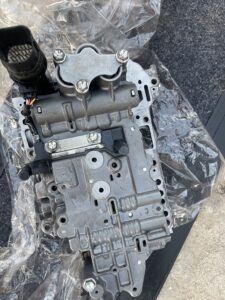-
 INTRODUCTION
INTRODUCTIONIn an automatic transmission, the valve body is a crucial component that controls the flow of hydraulic fluid to engage different gears and perform shifts. It contains various valves,
- passages, and channels that direct the transmission fluid to the appropriate clutch packs or bands, allowing the transmission to smoothly shift between gears and facilitate proper operation of the vehicle.
The valve body is essentially the brain of an automatic transmission system in a car. It’s a complex assembly made up of various valves, solenoids, passages, and channels that work together to regulate the flow of transmission fluid and control the shifting of gears.
Here’s a breakdown of its functions:
1. Gear Selection
The valve body’s primary function is to control which gears are engaged at any given time. When you shift your car into “Drive,” “Reverse,” or other positions, the valve body directs the flow of hydraulic fluid to activate the appropriate clutches and bands to engage the desired gear ratio.
2. Shift Timing And Smoothness
The valve body manages the timing and smoothness of gear shifts. Depending on factors such as vehicle speed, throttle position, and engine load, the valve body adjusts the pressure and flow of transmission fluid to ensure smooth transitions between gears.
3. Pressure Regulation
The valve body maintains the correct pressure within the transmission system. Proper pressure is crucial for effective clutch engagement, preventing slippage and ensuring efficient power transfer from the engine to the wheels.
4. Torque Converter Lockup
In some modern transmissions, the valve body controls the engagement of the torque converter lockup clutch. This helps improve fuel efficiency by reducing slippage and increasing direct mechanical coupling between the engine and the transmission.
5. Downshifting and Upshifting
The valve body is responsible for downshifting and upshifting the transmission as needed. For example, when you accelerate to pass another vehicle, the valve body downshifts to a lower gear for increased power. Similarly, during deceleration, it may upshift to optimize fuel efficiency.
6. Diagnostic Capability
Some valve bodies include sensors and solenoids that can provide feedback to the vehicle’s onboard computer. This feedback allows the vehicle’s computer to monitor the performance of the transmission and make adjustments if necessary.
A faulty valve body in an automatic transmission can lead to a variety of symptoms that indicate there may be a problem. Here are some common signs to look out for:
1. Erratic Or Harsh Shifting
One of the most noticeable signs of a body is when the transmission shifts erratically or shifts with a noticeable jolt or harshness. This can include delayed or sudden shifts between gears.
2. Slipping Gears
A malfunctioning valve body might cause the transmission to slip out of gear or struggle to stay engaged in a particular gear. This can result in a loss of power and poor acceleration.
3. Delayed Engagement
When you shift into “Drive” or “Reverse,” a delay in the engagement of the selected gear can be a sign of a valve body issue. The transmission might take longer than usual to respond.
4. Failure to Shift
If the valve body fails to direct transmission fluid to the appropriate clutches and bands, it can result in the transmission being stuck in one gear and not shifting at all.
5. Warning Lights
some cases, a faulty valve body can trigger the vehicle’s check engine light or a transmission-related warning light on the dashboard.
6. Flaring or Revving
Flaring occurs when the engine revs higher than expected during shifts. This can happen due to improper fluid pressure regulation by a malfunctioning valve body.
7. Transmission Overheating
A malfunctioning valve body can cause the transmission to overheat due to improper fluid flow, leading to reduced performance and potential damage.
8. Whining or Noise
Unusual noises, such as whining or grinding, during gear shifts can be indicative of issues within the valve body or the transmission as a whole.
CONCLUSION
Overall, the valve body plays a critical role in ensuring that the automatic transmission operates smoothly, efficiently, and reliably. Its intricate design and precise control over fluid flow enable the transmission to adapt to various driving conditions and deliver optimal performance.
If you experience any of these symptoms, it’s advisable to have your vehicle inspected by a qualified mechanic or transmission specialist. They can diagnose the issue and determine whether the valve body or another component of the transmission is at fault. Keep in mind that prompt attention to transmission issues can prevent further damage and potentially save you from more costly repairs down the line.






I was extremely pleased to find this web site. I want to to thank you for your time for this fantastic read!! I definitely appreciated every little bit of it and i also have you saved to fav to see new things on your web site.
https://empress-escort.com/escort-girls-beer-sheva/ Omega Laux
tadalafil coupon
What i do not realize is in fact how you are no longer actually much more wellfavored than you might be right now Youre very intelligent You recognize thus considerably in relation to this topic made me in my view believe it from numerous numerous angles Its like men and women are not fascinated until it is one thing to do with Lady gaga Your own stuffs excellent All the time handle it up
What i dont understood is in reality how youre now not really a lot more smartlyfavored than you might be now Youre very intelligent You understand therefore significantly in terms of this topic produced me personally believe it from a lot of numerous angles Its like women and men are not interested except it is one thing to accomplish with Woman gaga Your own stuffs outstanding Always care for it up